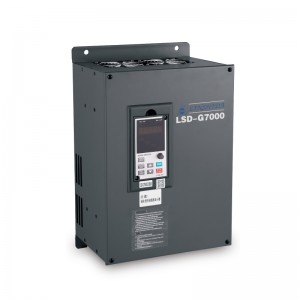1. Advantages of vector control system:
The dynamic “speed response DC motor is limited by rectification, too high di/dt is not allowed. Asynchronous motor is only limited by the High-performance General Vector Inverter LSD-G7000 capacity, the multiple of the forced current can be achieved very high, so the speed response is fast, generally acceptable Reaching the millisecond level, it has surpassed the DC motor in terms of rapidity.
Low-frequency torque increases. Generally, general-purpose frequency converters (VVVF control) are often lower than rated torque at low frequencies, and cannot work with full load below 5 Hz. Since the vector control frequency converter can keep the magnetic flux constant, the torque and it have a linear relationship, so the torque of the motor can be higher than the rated torque at lower frequencies.
The flexibility of control DC motors often choose separate excitation, series excitation, compound excitation and other forms according to different load objects. They each have different control characteristics and mechanical characteristics. In the asynchronous motor vector control system, the same motor can output different characteristics. Using different function generators as flux regulators in the system can obtain the mechanical characteristics of separately-excited or series-excited DC motors.
Using vector control, the output torque of the motor at low speed (without speed sensor) can reach the output torque of the motor at 50Hz power supply output torque (about 150% of the rated torque).
What are the advantages and applications of inverter vector control?
For conventional V/F control, the voltage drop of the motor increases as the speed of the motor decreases, which results in insufficient excitation and the motor cannot obtain sufficient rotational force. In order to compensate for this deficiency, the inverter needs to increase the voltage to compensate for the voltage drop caused by the reduction in motor speed. This function of the inverter is called “torque boost”.
The torque boost function is to increase the output voltage of the inverter. However, even if the output voltage is increased a lot, the motor torque cannot be increased corresponding to its current. Because the motor current contains the torque component produced by the motor and other components (such as the excitation component).
Vector control distributes the current value of the motor to determine the value of the motor current component that produces torque and other current components (such as the excitation component).
Vector control can optimize compensation by responding to the voltage drop at the motor terminal, allowing the motor to produce a large torque without increasing the current. This function is also effective for improving the temperature rise of the motor at low speed.
2. Application range of vector control system:
Working machinery that requires high-speed response: For example, the speed response of the industrial robot drive system must be at least 100rad/s, and the vector control drive system can achieve a higher speed response of up to 1000rad/s, ensuring that the robot drive system can work quickly and accurately.
Adapt to harsh working environment: For example, paper machines and printing and dyeing machines are required to work in high humidity, high temperature and corrosive gas environments. Asynchronous motors are more suitable than DC motors.
3. High-precision electric drive: For example, steel plate and wire coiling machines belong to constant tension control, which has high requirements for the dynamic and static accuracy of electric drive, which can achieve high speed (weak magnetic) and low speed (point movement). ). Forced braking when parking. After the asynchronous motor is applied with vector control, the static error is less than 0.02%, which may replace the V-M DC speed control system.
4. Four-quadrant operation: For high-speed elevators, DC drives were used in the past, but now they are gradually replaced by asynchronous motor vector control variable frequency speed regulation systems.
Post time: Jan-14-2022

